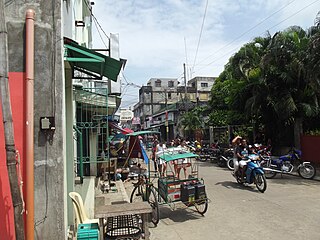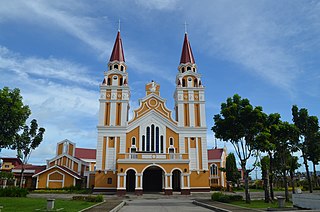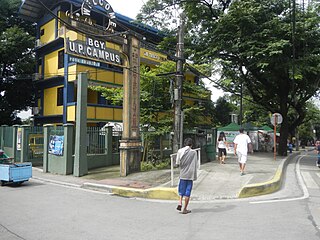
Quezon City, also known as the City of Quezon and Q.C., is the most populous city in the Philippines. According to the 2020 census, it has a population of 2,960,048 people. It was founded on October 12, 1939, and was named after Manuel L. Quezon, the second president of the Philippines.

Camp General Emilio Aguinaldo (CGEA), also known as Camp Aguinaldo, is the site of the general headquarters (GHQ) of the Armed Forces of the Philippines (AFP).

San Francisco, officially the Municipality of San Francisco, is a 1st class municipality in the province of Agusan del Sur, Philippines. According to the 2020 census, it has a population of 80,760 people.

Naval, officially the Municipality of Naval, is a 2nd class municipality and capital of the province of Biliran, Philippines. According to the 2020 census, it has a population of 58,187 people making it the most populous in the province.

Mogpog, officially the Municipality of Mogpog is a 3rd class municipality in the province of Marinduque, Philippines. According to the 2020 census, it has a population of 34,516 people.

Lemery, officially the Municipality of Lemery, is a 1st class municipality in the province of Batangas, Philippines. According to the 2020 census, it has a population of 93,186 people.

Palo, officially the Municipality of Palo, is a 3rd class municipality in the province of Leyte, Philippines. According to the 2020 census, it has a population of 76,213 people, making it the most populous municipality (non-city) in the province.
Ponciano A. Bernardo was a Filipino engineer and politician who served as mayor of Quezon City, holding the position from 1947 until his death in 1949. It was during his tenure that Quezon City was designated as the capital city of the Philippines.

The Victoriano Luna General Hospital, also known as Armed Forces of the Philippines Medical Center, is one of the Armed Forces of the Philippines' Wide Support Units tasked to provide medical care to military personnel and civilian human resources of the AFP, which includes their immediate dependents. It also refers to the healthcare facility complex that is occupied by the unit along V. Luna Avenue in Pinyahan, Quezon City.

Timog Avenue is a major road located in Quezon City within the Diliman area of northeastern Metro Manila, Philippines. It runs east–west through the southern edge of the barangay of South Triangle and is used to be named in English as South Avenue. The street is located in Quezon City's entertainment area, known for its trendy restaurants, bars and karaoke and comedy clubs. It is also home to the GMA Network Center studios located on the avenue's junction with Epifanio de los Santos Avenue (EDSA). The entire avenue is designated as National Route 172 (N172) of the Philippine highway network.

Socorro is a barangay located in Quezon City, Philippines, within the commercial district of Cubao. As of the 2019 census, the barangay has a population of 25,073 people. The barangay is home to Araneta City and Smart Araneta Coliseum, one of the largest indoor arenas in the world.

Central Signal Village, officially Barangay Central Signal Village and simply known as Central Signal, is one of the 38 barangays of Taguig, Metro Manila, Philippines. As of the 2020 census, the population was 44,126. The barangay was previously known as EM's Signal Barrio on January 25, 1965, and was created as Signal Village in 1972, before it was renamed on December 28, 2008.
Bernardo Park is an urban community park located on both banks of the Diliman Creek in Quezon City, Metro Manila, Philippines. It is the first public park in Quezon City which opened in 1948. The park is the social and cultural center of the barangay of Pinagkaisahan and the largest park in the barangay of Kamuning. It was named after Ponciano Bernardo, the second mayor of Quezon City who was also the city's first vice-mayor and city engineer appointed by President Manuel L. Quezon.

West Avenue is a major road located in Quezon City within the Diliman area of northeastern Metro Manila, Philippines. It runs north–south through the western edge of the barangay of West Triangle. The street is located in Quezon City's commercial-residential area, known for its restaurants, car shops, schools, and villages. It is also home to the old Delta theater located on the avenue's junction with Quezon Avenue. The avenue is a component of National Route 171 (N171) of the Philippine highway network.

East Avenue is a major street located within the Diliman area of Quezon City, Philippines. It runs north–south through the eastern edge of Triangle Park. The street is located in Quezon City's government area, known for different national and local government institutions, offices, and hospitals. It is also home to the Quezon City Hall Complex located on the avenue's junction with Elliptical Road. The entire avenue is designated as National Route 174 (N174) of the Philippine highway network.

Bungad is an administrative division in eastern Metro Manila, the Philippines.

Bagong Pag-asa, also known as the Magsaysay District, is an administrative division in eastern Metro Manila. It is an urban barangay of Quezon City with low-density housing and is known for its shopping malls, transport hubs and office buildings.

New Era is a barangay in Quezon City, Metro Manila, Philippines. It is noted for its dominant Iglesia ni Cristo population.

Philam, also known as Philam Homes, Philamlife Homes or Phil-Am, is an administrative division in eastern Metro Manila, the Philippines. It is an urban barangay located in the first legislative district of Quezon City, consisting entirely of the Philam private subdivision and gated community.

U.P. Campus is a barangay in Quezon City, Philippines. As its name suggests, a large part of the barangay is occupied by the main Diliman campus of the University of the Philippines (UP). UP Diliman, the university campus itself, covers seven other barangays in Quezon City, namely Krus na Ligas, San Vicente, Botocan, Culiat, Old Capitol Site, Pansol, and Vasra.























